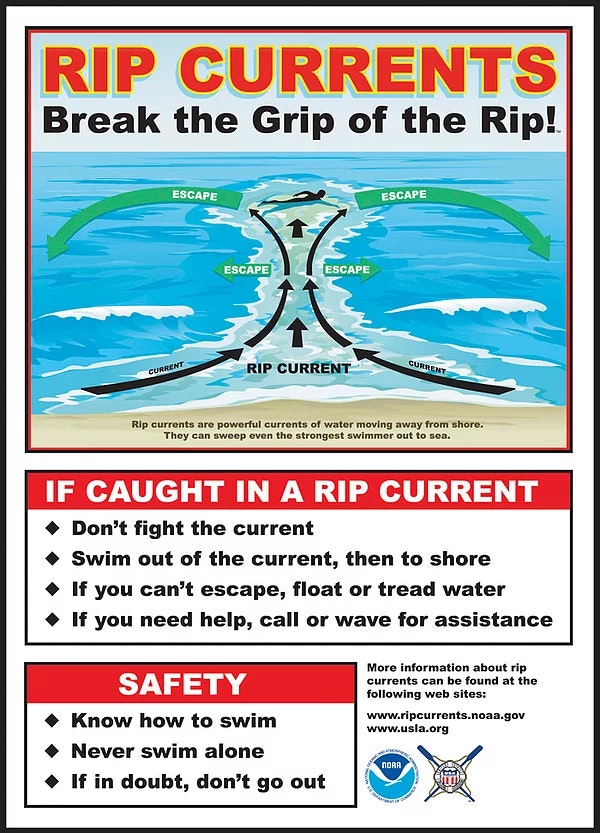Rip Currents
Beware of Rip Currents:
Rip currents are strong currents of water that rush out to sea. They are stronger than even the best swimmer. Rip currents can form on any beach that has breaking waves. If you look closely, you can see a rip current. It will have dark muddy water and be very choppy. You might see foam and other debris floating out to sea. If you see a rip current, stay away! They are very dangerous.
If you are ever caught in a rip current, don’t panic. Relax, and swim parallel to the beach. Don’t try to fight it. If you have trouble swimming, tread water and call for help. Parents! Keep your kids nearby when they’re playing near the ocean.
Identify a Rip Current
There are many rip currents and unsafe areas to swim in Cannon Beach. Swim near a lifeguard, read the semiphore signs, and/or ask the Cannon Beach lifeguards where safe areas are.
How to Escape from a Rip Current
Permanent Rip Currents:
Play a minimum 200 yards away from rip currents and any rock formations.
- North and South of Haystack Rock
- Chapman Point
- North side of Indian Beach
- Straight out from Gower Street Beach Access
- Straight out from Ecola Creek
- Any large rock face will have a rip current and/or strong current.
What to do if you’re caught in a rip current.
These are powerful, channeled currents of water flowing away from shore. They typically extend from the shoreline, through the surf zone, and past the line of breaking waves. Rip currents can occur at any beach with breaking waves or where a there is a stream or out flow into the surfline. The majority of ocean rescues made by lifeguards are due to victims struggling in rip currents.
- If caught in a rip current, remain calm to conserve energy and think clearly.
- Don’t fight the current. Swim out of the current in a direction following the shoreline. When out of the current, swim towards shore.
- If you are unable to swim out of the rip current, float or calmly tread water. When out of the current, swim towards shore.
- If you are still unable to reach shore, draw attention to yourself: face the shore, wave your arms, and yell for help.
- If you see someone in trouble, get help from a lifeguard and/or pull the semaphore. If a lifeguard is not available, have someone call 9-1- Do not leave the scene until first responders arrive, speak to you, and give you the ok to leave. First responders need to gather information for rescue operations.
Instructions in case of an emergency – call 9-1-1
- If you see someone in trouble, get help from a lifeguard and/or pull the semaphore. If a lifeguard is not available, call or have someone call 9-1-1.
- Try to remain calm. Have someone spot the person in trouble or keep your eyes on the person. Give clear explanation of your location and stay on the line with the dispatcher until you are told otherwise.
- Throw the rip current victim something that floats and yell instructions on how to escape by having the victim swim out of the rip current, in a direction following the shoreline. When out of the current, direct them to swim towards shore.
- Do not leave the scene until first responders arrive, speak to you, and give you the ok to leave. First responders need to gather information for rescue operations.
- Only professionally trained rescuers should attempt in-water rescues.
Remember, many people drown or become victims themselves while trying to save someone else from a rip current.

